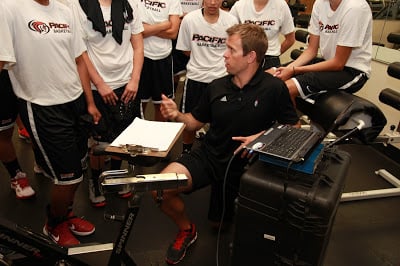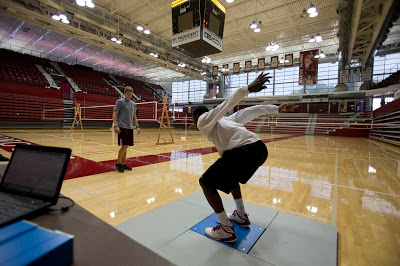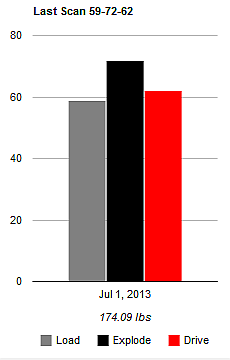
It is one the most confusing questions when performing a vertical jump on the force plate. In fact, just yesterday, we were testing a female collegiate basketball team, and their best player is a guard who was just not interested in a test that measured her vertical jump. After all she is 5’ 6”, and no team would rely on her blocking or rebounding, skills commonly attributed to vertical jump ability
However, the Scan does not assess her jump height; we assess the vertical jump because it is a basic, almost primal skill, unlike shooting or a sprinting, so eliminate any bias for technique. Put simply, the vertical jump gives us insight into how she drives through the lane and how fast she can run up and down the court during a fast break.

Another major reason to assess the vertical jump, other than the lack of skill, is the inherent requirement for translating rotational into linear motion. Energy is initially created by initial rotational movement; the hips moving backwards and the arms swinging behind you to the ceiling, is transferred by biarticular muscles, particularly the hamstrings which serve to extend the hips.
Linear motion, often called translational, is movement along a straight line and rotation motion, also called angular, is movement about an axis of rotation. Biomechanics and track coaches’ education are experts on defining these terms. “Movement is usually a combination of linear and rotational motion. A sprinter’s body, for example, has linear motion but the movement is caused by the rotational motion of the legs. Both forms of motion take place to produce the general motion of running. A discus thrower uses rotational motion to build up speed before releasing the discus. He also moves with linear motion from the back to the front of the throwing circle.”

Athletes with a linear athletic movement signature have a lower LOAD, and a greater EXPLODE and DRIVE. It is not to say these athletes are not explosive or weak because LOAD is excessively low, the relationship is relative. All 3 of the athletic movement signatures (see Sparta Point ) have a healthy balance, by either possessing a smaller relative difference between all 3 variables (within 7), or the lowest variable having a T score above 45.
These athletes tend to be the most graceful, they use the proximal-distal sequencing the best in order to time their movements and maximize the EXPLODE and DRIVE phases. While they may not optimize their initial force production (LOAD), they transition and finish well. Such sequencing requires speed to be increased slowly, but can maintain it in a straight line. As a result, linear athletes excel in skills that favor more prolonged sequences such as stride length in sprinting or blocking a shot in the high corner of the goal.
One of our coaches referred to them as just “anti-ankle/knee people.” They avoid bending very often, whether it is the avoidance of deeper squats in a training session, or a limited range of movement in their sport itself. Related factors, such as knee pain, sprained ankles or a history of chronic ankle bracing/taping, could cause a loss in their range of motion and a sequence that just chooses to initiate movement at the hips, trunk, or arms rather than the knees and ankles.
There is certainly a genetics and/or anthropometric component to all movement signatures. These athletes tend to be ectomorphs, a human physique classification system that oddly enough describes these body types as “linearity.” The ectomorph has longer arms and legs, low body fat, and does not gain weight easily, making momentum an easier solution rather than creating more force through more body mass or maximum strength.
Because linearis an athletic movement signature; injury risks are significantly lower compared to the extreme and the weak signatures (discussed more in upcoming weeks). Rather we focus on the positives, in particular performance.
A recent 2013 study out of Slovenia examined vertical jumping and the key factors that differentiated elite and sub-elite sprinters. The authors found elite sprinters had 3 clear advantages; they jumped higher, left the ground faster (EXPLODE), and had a greater impulse (DRIVE).
When we discuss linear skills, sprinting is perhaps the most common, but a more accurate term is acceleration (Sparta Point). Acceleration is the athletes’ ability to increase their speed from a standstill (after the ball is snapped in football) or from a lower speed (switching from a jog to sprint in soccer). Interesting enough, the acceleration phase requires even more impulse. Think about pushing a heavy box, it gets easier when you get some momentum going, which explains why another word for impulse is the change in momentum
Identify the linear (Or at least from observation of their movements, sport history, and somatotype)
Compare yourself to linear based movements/positions (Volleyball outside hitters, basketball players that drive through the lane, wide receivers)
Adjust training as needed (Performing more squats will not help your linearneeds if LOAD is sufficient)